
Limit switches for liquids are used as in process engineering plants as the standard means to register high and low liquid levels in vessels to prevent overspill during filling, and pump burnout during emptying, but may also be used for pump control and inventory control.
In this article the requirements of such a universal limit switch are summarised and discussed using, as an example, a vibronic limit switch.
Level measurement for the determination of the level of the product surface above a stipulated reference level represents a critical variable for all process plant facilities, be it tank farms, food plants, chemical or pharmaceutical production sites or operations of the water and waste water industry.
Continuous level measurement - using a variety of technologies, eg ultrasonic, microwave, capacitance, etc - applies generally to inventory control, either to ascertain the value of raw product, or the volume. Such measurements need to be supplemented by level switches for the control of filling or emptying.
Limit switches are not only used for the automation of processes, they are also important for safety. They supply digital signals for filling or discharge equipment and trigger an alarm when certain limits are surpassed, e.g. in overspill protection. While numerous technologies are available from which to select a measurement principle for a given application, it is more cost-effective to obtain a universal limit switch, and benefit from economies of scale, which may be employed safely in most existing applications.
Universal limit switch
In the determination of the characteristics of a 'universal' limit switch it must be accepted that there will be difficult process applications that will require special, custom-made solutions. Because of the large variety of applications a 'universal' limit switch is defined for our purposes to be a device which is able to cover more than 80% of all applications occurring in practical operation. The discussion of these characteristics must not only include the sensor, but the whole instrument. Figure 1 depicts typical installation of limit switches.
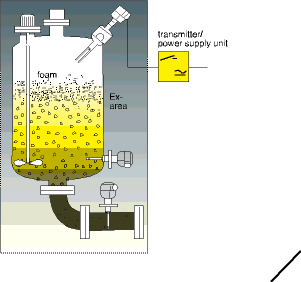
The complete measuring instrument comprises the sensor with its integrated electronic module, a transmitter which functions as a power supply, controller and switch. The transmitter evaluates the signals and forwards the information to the control room, eg to a process control system, via switch outputs. The instrument is often designed with intrinsically safe circuits and these may be employed in hazardous areas. Universal limit switches should allow installation at any point, be largely independent of process influences such as build-up, corrosion, plant vibration, turbulence and changing temperature and pressure. It is also important that the switch should not require any calibration.
An application of a particularly critical nature is the overspill protection in storage tanks for hazardous liquids. Limit switches are used in addition to continuous measurement and are usually not reached by the product. Nevertheless, they have to stop the filling operation in case of a failure in the continuous measurement once the maximum level has been reached. If the limit switch fails and causes a breakdown in the measuring function, it has to send an alarm to the control room.
Transmitters must be subjected to the same high demands. They have to be able to transmit the information received from the sensor safely and, in addition, detect a break of the sensor cable or a short circuit and alert the operator via a safety circuit. These requirements of a universal limit switch are subsequently discussed using the example of a vibronic limit switch for liquids.
Vibronic limit switch
Vibronic limit switches are systems that vibrate mechanically. They are made to vibrate at their resonant frequency in air and this frequency changes when immersed in a liquid. If the frequency falls below a certain value the sensor transmits a signal to an electronic system that it has been covered or uncovered.
The electro-mechanic resonant circuit may be demonstrated by the oscillation model of a spring-mass system and described by a linear differential equation of the second order:
The mass moment of inertia is defined by the integration over the whole fork geometry

and the oscillating amplitude amounts to:


The level is deduced from this change in the resonant frequency in the air and in the liquid. The difference of the two formulated equations scaled to the resonant frequency in the air results in the scaled sensitivity of:

It becomes apparent that the measuring effect is only a function of the two ratios of the mass moment of inertia of the tine and the simultaneously moved portion of liquid. A variation in the sensor geometry permits the design of oscillating tines which cover a wide range of applications in respect of pressure, temperature, density and viscosity and which are not effected by interferences like build-up, foam, turbulence and corrosion. Optimising of the fork geometry is usually based on simulation calculations employing the finite-element method.
The most common sensor is an oscillating fork with two tines, the root of which ends in a diaphragm of a thickness of approximately 1 mm. The tines are approximately 40 to 130 mm long.
The fork is made to operate at its resonant frequency by a piezo-electric drive via the diaphragm. Depending on the mass moment of inertia of the fork, this amounts to about 400 to 1000 Hz in air. Higher values of this frequency diminish the risk of the sensor being affected by plant vibrations, as caused by connected motors for instance.
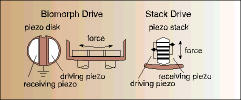
Piezoelectric transmitting and receiving unit
The most common designs of the piezoelectric unit of a vibronic limit switch are either bimorph radial oscillators or piezo stacks oscillating vertically (see Figure 2).
A transmitter piezo converts electrical energy into a mechanical energy and a receiver piezo converts the frequency into an electric signal. The piezo drive thus measures the loss in energy between the transmitted and received vibrations.
The receiver piezo supplies the feedback signal for the fundamental wave excitation of the oscillating system. For this excitation, the filtered electric received signal is led to the transmission amplifier via a phase shifter so that the oscillating tines, the surrounding medium, the piezo drive and receiver as well as the control electronics from an oscillating system. This always oscillates at its resonant frequency. In addition, the amplified signal is passed to the evaluation electronics and analysed in respect of the change in frequency. The resonant system is shown in Figure 3.
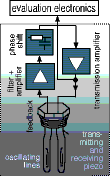
When the tines are covered, the resonant frequency declines because of the additional mass of the liquid. The switch point of the sensor is defined from the change in frequency. A switch hysteresis of approximately 30 Hz is used between the switch activation and deactivation point for the suppression of plant vibrations. This corresponds to a hysteresis in the switch point of approximately 2,5 mm. Furthermore, to prevent incorrect switching due to surface turbulence, there is a time delay of approximately 1,5 s.
Corrosion
Corrosion of the sensor will critically impact on the operation of limit switches for overspill protection. The safe operation of the sensor must be ensured, even if it is partly corroded, in the form of an alarm to be triggered upon failure of the switch. The decline in mass of the tines increases their resonant frequency and the set of characteristic curves shifts to higher frequencies. The effect of corrosion causing uneven wear and tear on tines is shown in Figure 4.
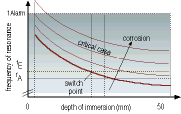
Typical limits of application
Although the thermic application limits of a piezo are determined by the typical Curie temperature of 350°C, bonding agents and soldered contacts in the sensor and different coefficients of expansion of materials reduces the operational range to -40 to 150°C as a rule.
The application limits in respect of pressure are to be found at the point where the sensor experiences an irreversible plastic deformation. These sensors are able to withstand a 1,5-fold nominal operating pressure without any irreversible plastic deformation.
Process pressure only has a minor influence on measurements. An increase in pressure leads to the deformation of the diaphragm and to mechanical tension at the piezo, this influencing the electro-mechanic characteristics. The change of the switch point of a typical vibronic limit switch in dependence on pressure and temperature is shown in Figure 5. It merely changes by a few millimetres in the range of 0 to 100°C and -100 kPa to 6 MPa (-1 to 60 bar).
Typical viscosity limits with regard to limit switches with oscillating tines are to be found at 10 000 mm2/s. Figure 5 shows the change in frequency in dependence on the depth of immersion in liquids of different densities.
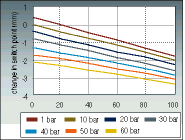
Transmission
Since level switches are critical to operation, it is important to consider not only sensor contact with the process but also reliable, failsafe output from the sensor. Depending on the nature of the application - in other words whether it is a hazardous environment or not - either compact or remote electronics can be employed. The reason for using remote electronics in hazardous environments is to limit current at the application.
Compact electronics for nonhazardous areas
Typical switching methods in compact electronics would be DCPNP transistor switches or relay output switching.
Remote electronics for hazardous areas
4 to 20 mA coding has become the standard in continuous measurement instrumentation. Binary signals are coded in this type of signalling with, eg 8 mA for the covered condition and 16 mA for the uncovered condition. An error can be shown with 3,6 mA.
The NAMUR DC interface for displacement transducers and switching amplifiers as described in DIN 19234 /EN 50227 has become another standard based on current signals. The two switching conditions are represented with 1,2 mA (unswitched) or 2,1 mA (switched). An error cannot be transmitted separately. In overspill protection, an internal error, like the covered condition, is coded.
The pulse frequency modulation shown in Figure 6 represents another, very safe type of transmission via a two-wire line. Current pulses, the repetition rate of which corresponds to the sensor condition, superimpose a quiescent current of 10 mA. 50 Hz correspond to the covered condition, 150 Hz the uncovered condition and errors are coded with 0 Hz.
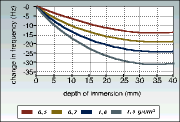
In conclusion
Starting with the general requirements of a 'universal limit switch for liquids', this contribution discussed the characteristics of a vibronic limit switch. Applicable to about 80% of all applications occurring in practical operation, both the physical measurement principle and the electronic units for frequency evaluation and signal transmission were demonstrated, focusing on a limit switch as an overspill protection which must guarantee safe functioning even in extreme applications.
Endress+Hauser
(011) 262 8000

© Technews Publishing (Pty) Ltd | All Rights Reserved